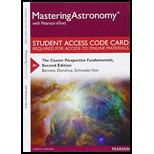
Concept explainers
The object which has the smallest radius.
Answer to Problem 1QQ
The white dwarf with
Explanation of Solution
Introduction:
When a low mass star reaches the end of its lifetime, it sheds its outer layers in the form of nebula. Its core stands exposed and this exposed core of the star is called the white dwarf.
A white dwarf has a very large gravity at its surface because they have masses equal to stars but a very small size. The star is kept in equilibrium due to a counter pressure called the electron degeneracy pressure, when the inward pressure due to gravity is countered by the outward degeneracy pressure.
It is found that the more the mass of the white dwarf, smaller is its size. This is because the large mass results in greater gravitational forces, which compress the star to a greater extent.
A white dwarf of mass equal to
Thus, option a is correct and b is incorrect.
Jupiter is the largest planet in the solar system with a radius of about 11.2 times the Earth radius, making it the largest of the given objects.
Thus, option c is incorrect.
Conclusion:
Of the objects-(a) 1.2
Want to see more full solutions like this?
Chapter 10 Solutions
Mastering Astronomy With Pearson Etext -- Standalone Access Card -- For The Cosmic Perspective Fundamentals (2nd Edition)
- Which of the below is a possible evolutionary outcome for the Sun (given in the correct chronological order). a) planetary nebula, red giant, white dwarf b) Red giant, planetary nebula, white dwarf c) Red giant, planetary nebula, neutron star d) Red giant, neutron star with simultaneous supernova explosion e) Red giant, black hole with simultaneous supernova explosionarrow_forwardA Type Ia Supernova is an example of a: a. Parallax object b. Moving cluster object c. Standard ruler object d. Standard candle objectarrow_forwardWhen a mass is transferred through the inner Lagrangian point in a binary system toward a white dwarf, the material forms a rapidly growing whirlpool of material known as a(n) a. accretion disk. b. Lagrangian point. c. Algol paradox. d. planetary nebula. e. supernova remnant.arrow_forward
- Given the mass of the sun (1.989 x 10^30 kg), calculate the average density of a neutron star with a radius of 45.439 km.arrow_forwardWhich of the following is least reasonable regarding novae and supernovae? Group of answer choices A type I (carbon-detonation) supernova results when a white dwarf in a binary system absorbs enough mass from its companion to push it over the Chandrasekhar limit. A type II supernova results from any supermassive star at the end of its life, when it runs out of fusion energy and collapses. A nova can occur multiple times in a binary system. If a white dwarf in a binary system absorbs enough mass to go beyond the Chandrasekhar limit, the white dwarf explodes as a supernova. The reason a type I supernova does not produce hydrogen lines is that the explosion originates from a stellar core (white dwarf), where hydrogen has already fused to produce heavier elements (so there is no longer any hydrogen). More supernovae are observed in the Milky Way because they are much closer to us than those in other galaxies.arrow_forwarddescribing the various stages in the life of a 1.0 solar mass star, 0.5 solar mass star, and a 3.0 solar mass stararrow_forward
- 41, Type 1a supernovae are not: The result of exceeding the Chandrasehkar limit. Produced by accretion from a donor or mergers. Least bright of all supernovae The result of the explosion of a carbon-oxygen white dwarf.arrow_forwardThe radius of a typical white dwarf star is a just a little larger than the radius of Earth, but a typical white dwarf has a mass that is similar to the Sun’s mass. Calculate the surface gravitational field strength of a white dwarf with a radius of 7 x 10^6 m and a mass of 1.2 x 10^30 kg. Compare this to the surface gravitational field strength of Earth.arrow_forwardA Type Ia Supernova is an example of a:arrow_forward
- If a stellar remnant is greater than 3 solar masses, the resulting object will be a a. red dwarf. b. white dwarf. c. neutron star. d. black hole.arrow_forwardList the following 5 terms in order through a stars life cycle (starting with the sun), through the remainder of its lifetime: a. Black dwarf b. Planetary nebula c. Red giant d. Star (Sun) e. White dwarfarrow_forwardRank these astronomical objects based on their density, from smallest to largest. A) the singularity of a black holeB) a main sequence starC) a typical neutron starD) a one solar-mass white dwarfarrow_forward
 Foundations of Astronomy (MindTap Course List)PhysicsISBN:9781337399920Author:Michael A. Seeds, Dana BackmanPublisher:Cengage Learning
Foundations of Astronomy (MindTap Course List)PhysicsISBN:9781337399920Author:Michael A. Seeds, Dana BackmanPublisher:Cengage Learning Stars and Galaxies (MindTap Course List)PhysicsISBN:9781337399944Author:Michael A. SeedsPublisher:Cengage Learning
Stars and Galaxies (MindTap Course List)PhysicsISBN:9781337399944Author:Michael A. SeedsPublisher:Cengage Learning An Introduction to Physical SciencePhysicsISBN:9781305079137Author:James Shipman, Jerry D. Wilson, Charles A. Higgins, Omar TorresPublisher:Cengage Learning
An Introduction to Physical SciencePhysicsISBN:9781305079137Author:James Shipman, Jerry D. Wilson, Charles A. Higgins, Omar TorresPublisher:Cengage Learning


